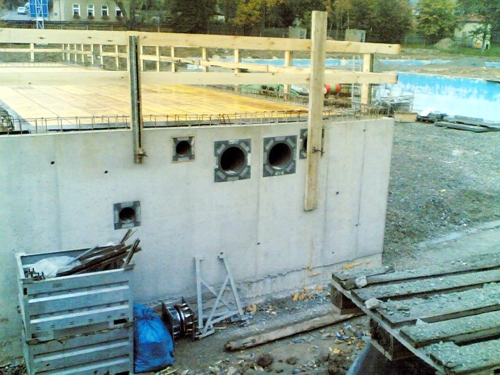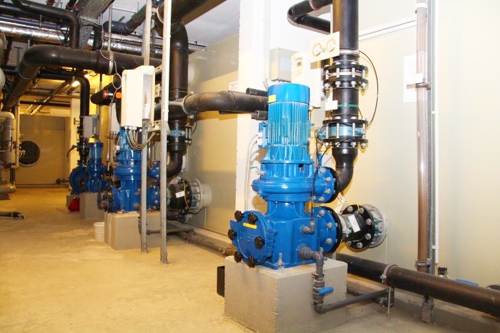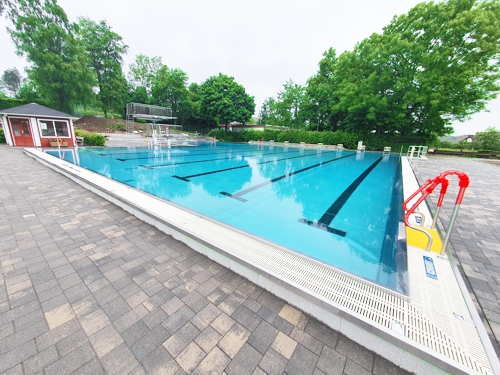Published in: Das Schwimmbad und sein Personal, edition 10/2015
Thoughts on the raw water tank
Usually he leads a lonely existence, the raw water tank. No one wanted him, now the overflow channel makes it necessary. Previously, yet everything was so easy, now you have to make a head, when the gray box in the earth needs a new water. Sometimes, the box is also suspected, just drink the water away. The necessary "selection" of things, that arrive in the tank as litter of the overflow, not exactly stimulates to unbridled enthusiasm. It seems so simple: "A lot of (tank volume) helps a lot!“, as so often in life, it is then not so simple. Because much volume costs a lot of money, much volume has a large surface and produces many losses and therefore that costs money again. A large tank requires a lot of space, which is often not available. This is offset by the risk, that a too small tank periodically overflows and so wasted the water. The interests of the architect should be clear, on the one hand risk - on the other side fees.

Photo: aqua&pools, Reichenbach Vogtland
The calculation process in accordance with DIN
Following the DIN 19643, so the volume is from this raw water tank 3 components together:
- VV: displaced by the bathers pool water volume, in m3,
- VW: the raw water volume (raw water volume), in m3,
- VR: the water supply for cleaning of the filter, in m3, VR ≥4×AF,
Anyone who has wondered in the last two episodes of this series about the many formulas, is coming at this point fully at his expense! That everyone (theoretical) bather 75 Liters of water displaced from the tank into the raw water reservoir, that is under (1) each understand. Whether a few heavyweight Americans are here, the authors chose not recorded.
In turn, DIN-compliant land use of 4,5m² per bather, whether in the generations -10 or 70plus, so should now 56 be people in the water in our sample pool, then displace the water 4,2m³.
But the flush water volume makes it exciting:

For simplicity, we assume the pool from the last post and expect with the values of 25×10-meter swimming pool. The circulation capacity is 110m³/h and the scope = gutter length 70m.

Correct, it still remains VR. Although the filter surface is discussed in a later article, we need it now. To make it short, we do not work with salt water, therefore, the filtration rate in the example is 30m/h. Using the values from above:

All amateur physicist and mathematics please, the disparate units I have not thought up. This follows the principle "It is written!“
The audit task would (hopefully) pass, everything is by letter of DIN 19643 calculated. We need a tank of 27m³ water as a net content.
Why VW, if we calculate flush water? Was VW not originally depend on the wind? What is the difference between outdoor pool at the North Sea and a indoor pool freed from any drafts in lung sanatorium? What, if precoat filters are used with less water? Before a lobbyist now feels threatened, other filters sparingly with rinse water too. But is the building design is already clear, which direction will take the tender in water technology? Where do we set the feeding of the raw water tank, at 27m³ or at half or zero, just before the tank is empty?
This time, we expect about the description of the function
Without claiming, this calculation would be wrong, I would like to approach the subject from the direction of the function of the raw water tank. So let's imagine the raw water tank at our sample tank, without first defining the exact volume.
The entire system is imaginary at a standstill, as usual in mathematics, let the volume of water be Vx now just in the tank. What is happening, if the system is approached?
The previously empty overflow channel and the overflow water pipes fill up, because they use a gradient to transport. Now we could use our calculation from the two previous contributions (but who has since been recalculated ...) and accurately calculate, how much in which flow is in gutter and pipes OR we will act according to the procedure "could not be better" and set the full volume one. For the channel we choose 0,04m² cross section with 70m circumference and get 2,8m³. The gap is still unclear, but we choose a pipeline DN200 and a distance to the tank of 15m, then we come to this 2,2m³.

Photo: aqua&pools, Neuruppin Fontane Therme
So if the system is put into operation, then disappear maximum 5m³ from the raw water tank. Let's call this VQ. A lower water level can not be achieved (If the pool is dense) but of course this can not be zero. If only, you should check the basement same time. Before switching on, it must be 5m³ plus the reserve for safe operation of the pumps in the tank.
But what, if the flow rate at 75% is? Where then is the water? Or at 50%? Or somewhere in between? OK, you could take the formula from the last post and now expect. If you have prepared it, it goes fast. But it is easier with patience, if the system works, you can easily determine it in reality by changing the flow and logging the behavior. Here is a good example, already with the average values of 5 measurements fed.
| wdt_ID | Water flow | water level |
|---|---|---|
| 1 | 0.00 m³/h | 2.30 m |
| 2 | 20.00 m³/h | 1.90 m |
| 3 | 40.00 m³/h | 1.60 m |
| 4 | 60.00 m³/h | 1.40 m |
| 5 | 80.00 m³/h | 1.20 m |
| 6 | 100.00 m³/h | 1.10 m |
| 7 | 120.00 m³/h | 1.05 m |
| 8 | 140.00 m³/h | 0.95 m |
| 9 | 160.00 m³/h | 0.88 m |
| 10 | 180.00 m³/h | 0.85 m |
At the end a mathematical function is obtained, which describes the dependence of the filling level in the tank too the flow.
In the diagram, looks like this, when displaying the data:

mixed a little Excel to, you can already see the trend lines in the graph. I first tried it with the exponential (because I hoped, there to find the reference to the DIN formula again), but then decided on the red line polynomial of third level. The formula is shown behind it and can be taken quite well into the control, but later a few sentences to this.

In general, the raw water pumps are not appropriate under the tank. So that they can suck in air-free, water is required in the tank. Depending on the design, setup and automation of the pump can 10 ... constitute 50cm water level in the tank. Let#s call this volume VNull (Zero) and appreciate it with 2,0m³. So now we know, how much water must be stored in tank, so that we the system (in case of "no wind") can start. Vx= 7m³.
If now, as we expect yes, 56 jumping people in the pool, the water level rises by 4,2m³. but the people displace less water, as used in the channels and pipes was. The tank now has 6,2m³ water content.
When will filter cleaning
... is the all-important question! Have we planned, to be able to do the job within the opening time of the pool? The planner knows this overtime limiting dream? Then the planner has thought, that with ONE filter it would not be possible to switch off 100% -, with 2 filters the 50% residual volume flow become tight and with 3 filters 66% residual volume flow might suffice.. Already the amount of water required to clean the filters is divided by three, 5m³ (from the DIN calculation) sufficient for one of three filters.
In case of stillstanding the system this 5m³ would be available in the raw water tank! Because nothing was consumed in gullies and slopes pipes in this state. But we do not want to throw out all bathers and close the pools. At 66% flow water levels are significantly reduced in the channels, but it is not enough for cleaning.
At the same time we can 56 standard bathers or some from soft drinks, burgers and fries laboriously shaped voluminous water displacer not force, to stay in water for a filter cleaning. Thus, the question is a little different: Should at all be flushed out of the raw water tank? If so, then we must interpret our tank plus 5m³, so now is Vx= 7m³ + 5m³ = 12m³.
The argument of ass jump.
For an indoor pool we were with this calculation thus already at the end. But, yes, many people are starting to think about that now, what was with the water displacers, if they send by using the 10-meter tower a mini-tsunami in the overflow. Even if the tsunami sent 5m³ into the channel - in the next few seconds the channel receives no further water, because this is missing in the pool. Gutter and pipes act as a time buffer, they distribute such interference to a longer time. So the ass jump has no influence on the raw water tank. This extremely exaggerated example will also illustrate, that waves in the pool will not affect the tank, because they always consist of a wave crest and a trough. Almost philosophically, almost Yin and Yang.
The wind
... is for the pool, of course, important. Depending on wind strength he is able, to push the water in one direction. That in itself was not bad, because we had expected a large reserve for the gutter, so that this water can drain. Rather, we need to consider, that the wind the water level slightly "gives a slope". This is done depending on the wind strength and the length of the pool downwind. To remain in the marine language, we have to reckon on one side of the pool with a storm surge.
If our pool as large as the Baltic Sea, then we could with 2 meter difference expect. Now we are a little smaller on the go with our 25m pool. Tasting is about studying, I have in 20 years constantly values up to 2 ‰, so 2mm per meter, measured. On the one hand, the water level remains the same, because the overflow edge remains so unimpressed by the wind at an altitude, on the other hand, the water level drops so in our example pool to 50mm. How much is this?

Perhaps there is indeed among our members one, how has wind speed AND gap recorded. Then I ask the supplement to! I had no anemometer in my pocket. For the outdoor pool, the calculation means, that the reserve (upward) the tank has to be increased. Because the wind does not matter, whether the circulation is running or stopped.
For the (zero wind) state we had Vx= 7m³ + 5m³ expected = 12m³ expected . The tank therefore now has a size of
![]()
What to do with the float switches?
Off in the garbage bin! Instead, fire under the ass of the planner (or the programmer of the most outrageously expensive automation of the pool) if no analog system is installed. A analog system can display, what is the current level in the tank, whether through pressure, via sound or microwaves. Everything possible! Because is impossible, to say these two float switches, how much water because now is just go on pipe, how much water is displaced from the pool, whether a filter screams in the next minutes after cleaning. The automation know a large part of, why she does not tell the raw water tank? Because that's just a stupid tank? Then the refill but let's do so by the clever automatic.

Photo: Bernburger Freizeit GmbH
Coming back at this point on the trendline from the diagram. So the refill has to compare the current water level with the flow, add the cleaning water reserve and then decide, whether the valve needs to be opened.
Added a few lines in the program code, already is HSoll (Setpoint) known as a function of the volume flow. And if this is significantly below, then it can be refill.
Can it be a little more?
If the automatic system is fed with these contexts, then, for example, the emergency stop of the pumps can be avoided. Then do the automatic know, that the reduction of the volume flow can improve the water level in the raw water storage in the short term and responds accordingly.
If the automatic system is fed with the differential pressure of the filter, then the necessary flushing water can be stored in the short term and does not have to be dragged. Then can be displayed, when the filter can be cleaned - and when the water currently not sufficient.
If the automatic system is fed with the operating times, then the water supply can be fixed to certain times of the day - namely when it "goes well in terms of pressure," the water utility.
I'm sure, there are more arguments, on the raw water storage, slightly more than in the DIN described, thinking. Let's take ...
... the connection of the inflows.
Now we have hopefully enough broken our head, when and how much water in the tank.
From the guild of planning engineers often comes to mind, that the inlets have do placed above the (calculated from them according to DIN) maximal water level. Why? Because one so want to save a vent? Or because the internal water could be stronger than the external water? Or because there is not written in DIN, when each water level is expected in the tank? This small swipe of the side should please be ignore after the above explanations. To plan the system so easy according words and letters of a DIN once again needs a lot of money. Since I praise the raw water storage, the wasted no height and thus also costs less.
Result should be: The low point of the pipes is slightly above the normal operating point of the water table! So that the water does not fall unnecessary in the depth and the volume is not wasted. But this is just theory, because it is can be calculated exactly only in the later planning.
What, if forming the pipes in normal slope too high in the tank? The solution is to be found in the ATV-Rules civil engineering. There, the difference in height is overcome in front of a shaft by means of downpipe and horizontal overflow. If not outside, then the down pipe should be installed at least in the tank. The reason for the connection via an imaginary water level eliminates characterized, with the smooth connection and with a little brain power.
Who wants to try, here's a advice: Never forget the ventilation and recalculate the flush water system for geodetic flow! Geysers in the gutter would prove the little mistakes impressively!
What, when the tubes end too deep? Of course, not below ground level of the tank, because you have to just calculate and adjust the pipe cross-section corresponding. In the pipe of the accumulated water level has to be high, that the difference to the water level in the tank is sufficient, to achieve the necessary volume flow. If necessary, the pipeline must get a bigger size.

The water movement
Most of us know, what so everything ends up in the raw water tank. And let's face, who already controls the tank every day. So everything stays inside, what was once flushed? But you can also think about it before, and it is not left to chance. The right, tangentiale, Arrangement of the water inlets produces a rotational movement in the water and therefore all waste the pumps too. As I said, if you let the water just does not fall from the top simply! One might overdo it now and call, the right-handed for us in the Northern Hemisphere natural strudel, which explained the old Coriolis, drive instead of fighting this. But our raw water storage are fortunately too small for the effect of the "big" Physics.
Blessing and Curse in the same time, if we let it whirl, then everything ends up in the end only in the lint trap of the pumps. But this to cleans is more easily than the whole tank, or?
In the next post we talk about exactly this lint trap and the pumps, which hanging it. Thank you for the interest! ♦

Print View
If the view is not yet visible, Please wait a few seconds or refresh the page.
Thank you!
 Loading...
Loading...
For registered members here the print version as PDF:
[wpdm_package id=’1767′]









Leave a Reply
You must be logged in to post a comment.